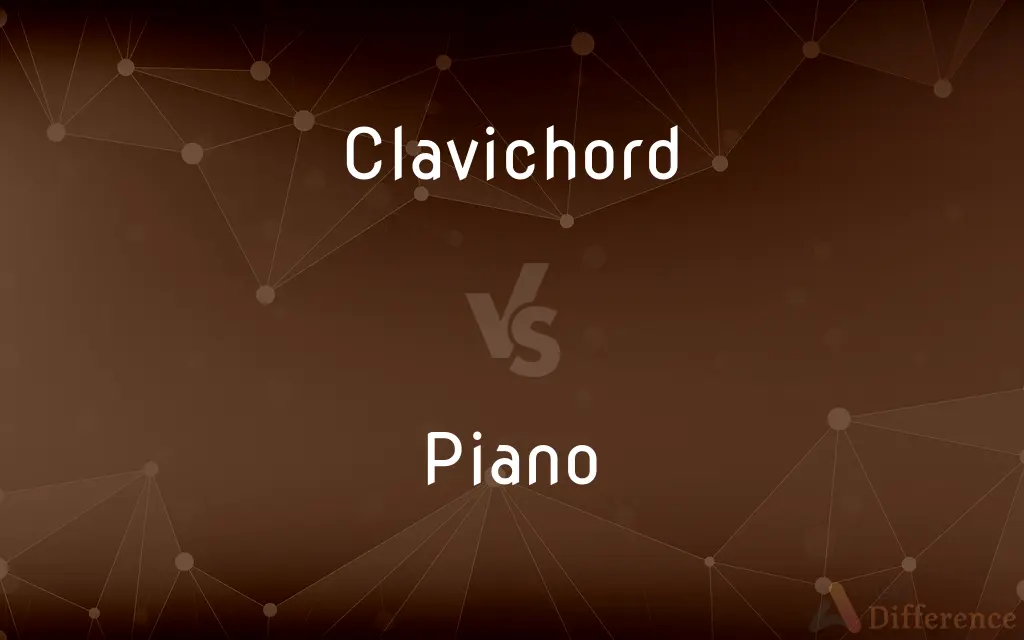Clavichord vs. Piano — What's the Difference?
By Fiza Rafique & Maham Liaqat — Updated on March 28, 2024
The clavichord is a quiet, early keyboard instrument with a delicate sound, played by striking strings with metal tangents, while the piano, a more modern instrument, produces sound by hammers hitting strings, capable of a wide dynamic range.

Difference Between Clavichord and Piano
Table of Contents
ADVERTISEMENT
Key Differences
The clavichord, developed in the Medieval period, is known for its subtle, expressive sound and ability to produce vibrato, making it suitable for intimate settings. It operates by pressing keys that move metal tangents against strings to generate sound, allowing for dynamic expression through touch. The piano, invented in the early 18th century by Bartolomeo Cristofori, revolutionized keyboard music with its hammer mechanism that strikes the strings, permitting a broad range of volumes and expressions from soft (piano) to loud (forte), hence its full name, pianoforte.
Clavichords are cherished for their ability to execute dynamic shading and nuances within a single note, an aspect that endeared them to composers and performers of Renaissance and Baroque music. The piano, on the other hand, with its greater volume and capacity to sustain notes through a pedal mechanism, became the instrument of choice for larger concert venues and a wide variety of musical genres.
Due to its quiet sound, the clavichord is more suited to solo practice or small, quiet spaces, limiting its use in large performances or with ensembles. Conversely, the piano's design allows it to be heard in large concert halls, making it a staple of solo and orchestral music performances alike.
The mechanism of sound production in a clavichord allows for direct finger control over the strings, offering a unique touch sensitivity that can mimic vocal-like inflections. In contrast, the piano's action, with hammers striking the strings, provides the player with the ability to produce a wide dynamic range, from very soft to very loud, supporting a more diverse repertoire.
While the clavichord offers an intimate musical experience with its nuanced sound and touch sensitivity, the piano stands out for its versatility, dynamic range, and the ability to sustain notes, accommodating the evolving demands of music composition and performance over centuries.
ADVERTISEMENT
Comparison Chart
Sound Production
Metal tangents strike strings directly.
Hammers strike strings, activated by pressing keys.
Volume
Quiet, suited for intimate settings.
Wide dynamic range, suitable for concert halls.
Expressiveness
High, allows for vibrato and subtle nuances.
High, with the ability to vary dynamics significantly.
Historical Period
Medieval, Renaissance, and Baroque.
Classical to modern times.
Use
Solo practice, small rooms.
Solo performances, ensembles, large venues.
Pedal Mechanism
Generally lacks pedals.
Sustain and other pedals enhance sound and sustain.
Size and Portability
Generally smaller and more portable.
Larger and less portable, especially grand pianos.
Touch Sensitivity
Direct control over strings allows for unique touch.
Key and hammer action provides wide dynamic control.
Repertoire
Suited for early music compositions.
Broad, covering a wide range of genres and periods.
Compare with Definitions
Clavichord
Known for its quiet sound, suitable for intimate musical experiences.
The clavichord's delicate sound is perfect for personal practice.
Piano
A musical instrument that produces sound by hammers striking strings.
Beethoven's piano sonatas exploit the instrument's dynamic range.
Clavichord
Predominantly used in Renaissance and Baroque music.
The clavichord was a favored instrument for early music compositions.
Piano
Capable of a wide range of volumes, from soft to very loud.
The piano's forte passages can fill a large concert hall with sound.
Clavichord
A keyboard instrument where keys control metal tangents that strike strings.
Bach composed many pieces ideal for the expressive capabilities of the clavichord.
Piano
Equipped with pedals for sustaining notes and other effects.
The sustain pedal on the piano allows notes to ring out longer.
Clavichord
Allows for dynamic expression directly under the player's fingers.
The clavichord enables performers to produce a vibrato effect by varying the pressure on the keys.
Piano
Offers expressive touch and dynamic control.
Pianists use the instrument's dynamic capabilities to bring emotional depth to performances.
Clavichord
Compact and portable compared to modern pianos.
Musicians appreciated the clavichord's portability during the Renaissance.
Piano
Central to classical and contemporary music performance.
The piano is a versatile instrument, used in everything from concertos to jazz.
Clavichord
The clavichord is a Western European stringed rectangular keyboard instrument that was used largely in the Late Middle Ages, through the Renaissance, Baroque and Classical eras. Historically, it was mostly used as a practice instrument and as an aid to composition, not being loud enough for larger performances.
Piano
The piano is an acoustic, stringed musical instrument invented in Italy by Bartolomeo Cristofori around the year 1700 (the exact year is uncertain), in which the strings are struck by wooden hammers that are coated with a softer material (modern hammers are covered with dense wool felt; some early pianos used leather). It is played using a keyboard, which is a row of keys (small levers) that the performer presses down or strikes with the fingers and thumbs of both hands to cause the hammers to strike the strings.
Clavichord
An early keyboard instrument with a soft sound produced by small brass wedges striking horizontal strings.
Piano
A large keyboard musical instrument with a wooden case enclosing a soundboard and metal strings, which are struck by hammers when the keys are depressed. The strings' vibration is stopped by dampers when the keys are released and can be regulated for length and volume by two or three pedals.
Clavichord
(musical instruments) An early keyboard instrument producing a soft sound by means of metal blades (called tangents) attached to the inner ends of the keys gently striking the strings.
Piano
A passage performed or marked to be performed softly.
Clavichord
A keyed stringed instrument, now superseded by the pianoforte. See Clarichord.
Piano
(especially as a direction) soft or softly.
Clavichord
An early stringed instrument like a piano but with more delicate sound
Piano
(especially as a direction) soft or softly.
Piano
A musical instrument with a manual keyboard actuating hammers that strike wire strings, producing sounds that may be softened or sustained by means of pedals.
Piano
A passage to be played softly or quietly.
Piano
In a soft or quiet tone. Used chiefly as a direction.
Piano
(musical instruments) a percussive keyboard musical instrument, usually ranging over seven octaves, with white and black colored keys, played by pressing these keys, causing hammers to strike strings
The piano in his house takes up a lot of space.
She has been taking lessons for many years and now plays piano very well.
Piano
To play the piano.
Piano
(of or with fingers) To move (the fingers) up and down on, similar to the motions of a pianist playing the piano.
Piano
To equip with a piano.
Piano
To become softer and less intense.
Piano
(music) softly, as a musical direction (abbreviated to p. in sheet music)
Piano
(music) Soft, quiet.
Piano
(in extended use) Gentle, soft, subdued.
Piano
Soft; - a direction to the performer to execute a certain passage softly, and with diminished volume of tone. (Abbrev. p.
Piano
A well-known musical instrument somewhat resembling the harpsichord, and consisting of a series of wires of graduated length, thickness, and tension, struck by hammers moved by keys.
Piano
A stringed instrument that is played by depressing keys that cause hammers to strike tuned strings and produce sounds
Piano
(music) low loudness
Piano
Used chiefly as a direction or description in music;
The piano passages in the composition
Piano
Used as a direction in music; to be played relatively softly
Common Curiosities
Is it easier to learn to play the clavichord or the piano?
Learning the piano may be initially more straightforward due to its more pronounced sound and dynamic feedback, but mastering the expressive potential of either instrument requires skill and practice.
What makes the clavichord unique among keyboard instruments?
The clavichord's unique mechanism allows direct finger control over the strings, enabling dynamic shading and vibrato within a single note.
Why is the piano considered more versatile than the clavichord?
The piano's wide dynamic range, ability to sustain notes, and adaptability to a vast array of musical genres make it more versatile than the clavichord.
How does the sound of a clavichord compare to that of a piano?
The clavichord produces a much quieter, more intimate sound with subtle nuances, whereas the piano offers a robust, wide-ranging sound capable of filling concert halls.
How did the piano improve upon earlier keyboard instruments?
The piano introduced a hammer mechanism that allowed for a wider dynamic range and greater volume, accommodating a broader repertoire and larger performance venues.
What role did the clavichord play in historical music education?
The clavichord was instrumental in historical music education, allowing students to practice with expressive sensitivity in a quiet setting.
Why has the piano remained popular while the clavichord has not?
The piano's versatility, dynamic range, and ability to project in large venues have sustained its popularity, while the clavichord's quieter sound has limited its use to more niche contexts.
Can the clavichord be used in modern music?
While not common, the clavichord can be used in modern music, especially in pieces that require its unique expressive qualities and sound.
Can the piano replicate the sound of a clavichord?
While the piano can mimic some aspects of the clavichord's expressiveness, its sound and touch are distinct due to the differences in their mechanisms.
What advancements in piano design have influenced modern music?
Advances in piano design, such as improved string and hammer materials and more efficient action mechanisms, have expanded its dynamic range and durability, influencing modern music's complexity and performance practices.
Share Your Discovery

Previous Comparison
Salami vs. Cervelat
Next Comparison
Hypoxia vs. HypoxemiaAuthor Spotlight
Written by
Fiza RafiqueFiza Rafique is a skilled content writer at AskDifference.com, where she meticulously refines and enhances written pieces. Drawing from her vast editorial expertise, Fiza ensures clarity, accuracy, and precision in every article. Passionate about language, she continually seeks to elevate the quality of content for readers worldwide.
Co-written by
Maham Liaqat















































